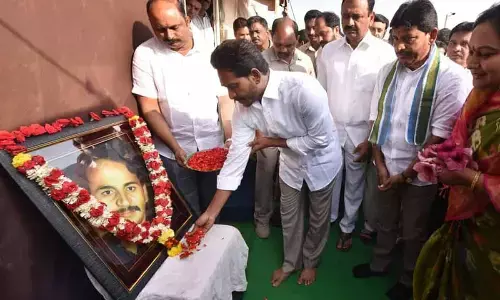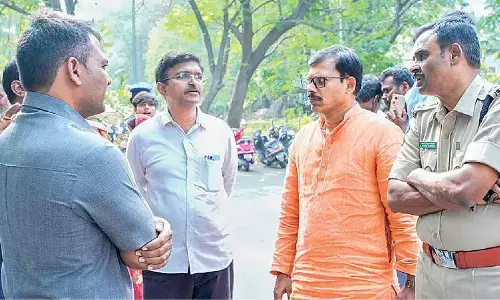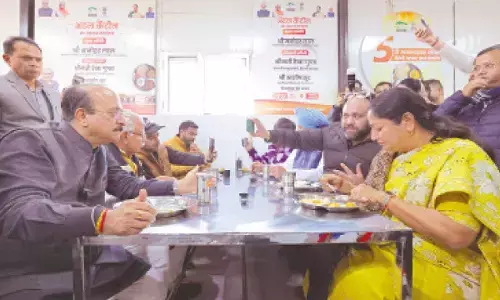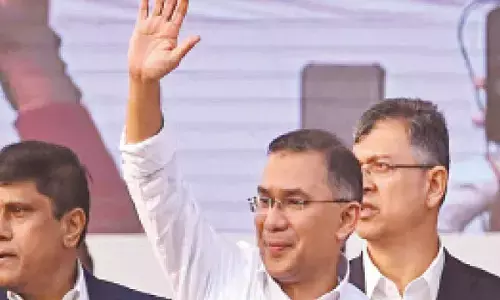Decoding Jobless Growth in India

Growth should be inclusive and sustainable. One of the crucial determinant of the same is it should be employment intensive. India has witnessed service of the economy and this has resulted in less job intensive growth. Further there are issues in policy orientations.
Growth should be inclusive and sustainable. One of the crucial determinant of the same is it should be employment intensive. India has witnessed service of the economy and this has resulted in less job intensive growth. Further there are issues in policy orientations.
Growth generates employment and employment generates further growth. In general, employment corresponds to the qualitative aspect of growth. If a country is on the growth trajectory, it will generate more employment opportunities and while the growth declines , people start losing jobs.
What is jobless growth?
Jobless growth is an economic phenomenon in which a macro economy experiences growth while maintaining or decreasing its level of employment.
Problem in India
- The estimated number of entrants into the workforce in the period 2005-10 was an average of 12 million per annum (But some experts believe that only about 7 million have been added to the labour force annually since 2005. This is due to a declining population growth rate and rising educational levels). This was a period when the economy grew at an average 8.7% and at above 9% in three of the five years. But despite this growth, the economy managed to create just 5.5 million jobs annually in the industry and services sectors in the same period. This is after accounting for new job creation through welfare schemes like NREGA.
- Further, not all new jobs went to entrants into the work force; a large chunk of it includes previously self-employed individuals from agriculture and trade who moved mostly into construction.
- In short, while new job addition in the five-year period was 27.5 million, the number of self employed people also reduced by 25.5 million, leading to a net increase of 2 million in the employed population
Reasons for Jobless growth
- It can be explained by differentiating between sectoral employment elasticity and aggregate employment elasticity of the economy.
- The model shows that aggregate employment elasticity depends on three factors: sectoral employment elasticity, relative growth of a sector and its employment share.
- So, even though manufacturing has the highest employment elasticity, its overall impact has been muted because of slow increase in employment share and low relative growth (ratio between growth of manufacturing and overall economy). By the same logic, agriculture is having a large negative impact on employment generation.
- These facts underline the importance of programmes such as Make in India to tackle India’s employment challenge.
- However, making such programmes successful would require swimming against the tide, shows a 2015 paper by Princeton economist Dani Rodrik.
- Traditionally, countries are expected to move on a transformation path of agriculture giving way to industry and industry ceding dominance to services.
- Service sector dominance is expected to arrive at very high levels of income.
- Rodrik’s paper shows that developing countries have been reaching their peak shares of income and employment in the industry at much lower levels of income in the post-1990 period.
Expected Questions
- Discuss relevance of a growth model that has employment orientation. Elaborate the ills of jobless growth on the economy.
Syllabus
General Studies 2
- Government policies and interventions for development in various sectors and issues arising out of their design and implementation.
General Studies 3
- Government Budgeting.
- Indian Economy and issues relating to planning, mobilization of resources, growth, development and employment.
Quality of new jobs added
- It is also under distress.
- The construction sector has created 18 million jobs, but a major chunk is in the form of casual labour. On the other hand, services has contributed only 3.5 million jobs.
- Manufacturing sector has actually lost around 5 million jobs.
Analysis
- There will be no demographic dividend without growth in industrial and service sector jobs.
- The underlying logic behind a dividend is that as jobs grow, incomes rise and so do savings.
- Based on higher savings, the investment rate to GDP grows, resulting in faster GDP growth.
- This was the reason behind the phenomenal growth in savings to GDP from 24 per cent in 2002-2003 to 38 per cent in 2007-2008 and investment from 25 per cent to 39 per cent of GDP.
- Economic growth is meaningful only as long as it creates new non-agricultural jobs.
- Job growth leads to an increase in consumer demand which has the effect of sustaining GDP growth.
Effect of infrastructure investment
- One of the most important sources of increased consumer demand since the turn of the century was the increase in infrastructure investment. Starting with the Golden Quadrilateral Highway network which began construction in 2001, infrastructure investment picked up. As a result, the number of workers in construction has increased.
- Investment in infrastructure has risen strongly thereafter, and during the 11th Five Year Plan, infrastructure investment in the public and private sector together grew by $475 billion. The result is that employment in construction sector has jumped.
- Thus real wages increased significantly till 2012.
- The combined effect of non-agricultural job growth plus real wage growth was a consumer demand booming in both rural and urban areas. The combined demand and supply effects of investment plus job growth resulted in sustained economic growth at a rate unprecedented in India’s economic history.
Labour Bureau Report
- Job growth has been much slower since 2012.
- The Labour Bureau of the Ministry of Labour has compiled data for job creation in labour-intensive non-agricultural sectors for each quarter since the 2008 global financial crisis. According to this,the lowest job creation has been recorded in 2015.
- For the first time in any nationwide sample survey, the Labour Bureau’s Annual Employment-Unemployment Survey Report in 2013-2014 showed that underemployment remains a major problem.
- Only 60.5 per cent of persons aged 15 and above who were available for work for all the 12 months were able to get work during that year.More worrying is the fact that for the 7 million young people who are joining the labour force, the open unemployment rate is 10 times higher than that for those 30 years and above.
Some worrying facts
- First, while the share of organised sector jobs is increasing, most of the job increases are still taking place in the unorganised segment of industry and services, and in informal jobs.
- Second, while construction had been booming from 2000 to 2012, its growth dipped since 2012, and has begun to revive only since late 2015 as infrastructure investment revived. With infrastructure investment tapering off during the fiscal years 2012-2013, 2013-2014 and 2014-2015, construction employment growth is likely to have fallen sharply, compounding the already greater rural distress caused by drought in 2014 and 2015.
- Third, education enrollment levels of youth joining the labour force have been increasing every year since 2010 or so. The educated youth are unlikely to join agriculture and will look for non-agricultural jobs in urban areas. The revolution in rising expectations is already causing social movements (the Patel and Jat agitations in Gujarat and Haryana, for instance).
Important schemes of government
- First, the Ministry of Labour is finalising the scheme to offer to pay 8.33 per cent of the salary as contribution for a pension scheme for new employees getting formal sector jobs. The scheme will be applicable to those with salary up to Rs.15,000 per month.
- Second, the Ministry of Commerce is customising incentives for labour-intensive export sectors. It has already initiated an Interest Equalisation Scheme and the Merchandise Exports from India Scheme to support declining exports, given that exports have been declining for 15 months. In the Budget, the government also announced that 100 per cent FDI in food retail will be permitted on the condition that the goods have to be manufactured in India.
- Third, under the Stand Up India scheme, Scheduled Castes, Scheduled Tribes and women entrepreneurs will get support such as free pre-loan training and facilitating loan and marketing. There will be a Rs.10,000 crore refinance window to the Small Industries Development Bank of India (SIDBI), and the National Credit Guarantee Trustee Company will create a corpus of Rs.5,000 crore. SIDBI will engage with the Dalit Indian Chamber of Commerce and Industry and other institutions to take the scheme forward.
Two main factors of India’s jobless growth
- First, India has an employability problem. While the services can rather easily recruit skilled white-collar workers (IT engineers, English-speaking people for the call centres, etc), the industry cannot transform peasants into factory workers so quickly. Such a transition requires basic training, which is missing. Moreover the main contributor in India’s GDP is service sector which is not labour intensive and thus adds to jobless growth.
- The fact that the government seems to rely on private initiatives in this domain also stands in stark contrast to an obvious reality: No country has developed without a robust public education system.
- The second factor according to some expert that needs to be pointed out pertains to the small and medium enterprises (SMEs). Their labour intensity is four times higher than that of large firms. The multinationals are particularly capitalistic, as evident from the commitments/ promises expressed during the last “Make in India Week” in February. While the investment commitments were impressive at $225 billion over five years, the fact that they would translate into the creation of 6 million jobs only was not trumpeted. In fact, the Make in India programme is revealing of the jobless growth syndrome: Highly capitalistic multinationals will start factories in India to sell their products to the white-collar middle class but will not create the manufacturing workforce the country is longing for.
Importance of SME in creating jobs
- SMEs, which employ 40 per cent of the workforce of the country and which represent about 45 per cent of India’s manufacturing output and 40 per cent of India’s total exports, are in a better position to create jobs.
- But it is not able to do so because of poor infrastructure, lack of skilled labour and also they don’t have easy access to loans.
Types of Unemployment
Demand-Deficient or Cyclical Unemployment
- Demand-deficient unemployment occurs when there is not enough demand to employ all those who want to work. It is also often known as cyclical unemployment because it will vary with the trade cycle.
Seasonal unemployment
- Seasonal unemployment is fairly self explanatory. In India agricultural employment is linked to monsoon and its behaviour. If there is a monsoon failure, unemployment results. The effects of seasonal unemployment are often highly regionalised.
Frictional or Search Unemployment
- When a person loses his job or chooses to leave it, he/she will have to look for another one. On average it will take everybody a reasonable period of time as they search for the right job. This creates unemployment while they search. The more efficiently the job market is matching people to jobs, the lower this form of unemployment will be. However, if there is imperfect information frictional unemployment will be higher.
Structural Unemployment
- Structural unemployment occurs when the structure of industry changes.
- Structural unemployment occurs when a labour market is unable to provide jobs for everyone who wants one because there is a mismatch between the skills of the unemployed workers and the skills needed for the available jobs.
National Sample Survey Organization (NSSO)
- The NSSO collects data through sample surveys based on scientific technique of random sampling through household enquiry both in rural and urban areas.
- National Sample Survey Organisation Concept of work.
- The NSSO has defined ‘work’ or ‘gainful activity’ as the activity pursued for-pay, profit or family gain or in other words, the activity which adds value to the national product. Normally, it is an activity, which results ‘in production of goods and services for exchange. However, all activities in ‘agricultural sector’ in which a part or whole of the agricultural production is used for own consumption and does not go for sale are also considered as gainful.
Issue
- Chief Economic Adviser Arvind Subramaniam recently pointed to the need to achieve higher economic growth, in the range of 8% to 10%, to solve the problem of jobless growth.
- In particular, he flagged the underperformance of the information technology, construction and agricultural sectors, which earlier served as huge job-creators for the economy.
- It is worth noting that India added just 1.35 lakh jobs in eight labour-intensive sectors in 2015, compared to the 9.3 lakh jobs that were created in 2011, according to Labour Bureau figures.
- The rate of unemployment grew steadily from 3.8% in 2011-12 to 5% in 2015-16.
- Union Labour and Employment Minister has downplayed the gloomy job situation as being a temporary one.
- The focus instead is on the new National Employment Policy which, accordingly, would be released later this year and focus on shifting jobs from the informal to the formal sector.
- NITI Aayog too has dismissed concerns over jobless growth, saying the real problem is underemployment rather than unemployment.
- Nevertheless, this month the government set up a high-level task force headed by NITI Aayog Vice-Chairman Arvind Panagariya to obtain reliable data on employment trends to aid policymaking.
Need for focus on Job oriented growth
- The focus on jobs is obviously vital. However, higher economic growth alone will not solve the jobs problem.
- Jobs can be created when growth comes from the transition of labour from informal sectors like agriculture to the more formal manufacturing and service sectors.
- Such extensive growth, however, runs the risk of stagnation once the available stock of informal labour is exhausted — as some Southeast Asian countries found out the hard way in the late 1990s.
- On the other hand, growth can come about without any substantial job-creation in the formal sectors of the economy, but through improvements in productivity.
- The growth record of several developed economies even after the modernization of their labour force explains such intensive growth.
- India should aim at growth that is driven both by improvements in productivity and modernization of its labour force — especially since better jobs are crucial to improving the lives of millions who are employed, indeed underemployed, in low-paying jobs in the farm sector.
- Ironically, achieving both those objectives will first require labour reforms — ones that can both boost labour mobility within the formal sector and bring down the barriers businesses face in hiring labour.
Concerns–Productivity vs Employment intensity
- If output is growing much faster than employment, it is obvious that the output per worker, or what we call labour productivity, is rising rapidly.
- This can happen either through technical progress in individual sectors or through growth-enhancing ‘structural change’, which means that the relatively productive sectors expand their share in national employment at the expense of other sectors.
- While recent research has shown that growth – through both these channels of productivity growth – has reduced poverty in India, one can easily argue that employment growth lagging behind the growth in working-age population can have adverse economic, political and social consequences.
- The negative consequences have already manifested themselves in the form of the recent Jat, Patel, and Maratha agitations.
Contract enforcement
- Some of the reasons may be internal that have to be dealt with by private sector internally.
- But, the government can’t escape the responsibility for external mismanagement that adversely affects manufacturing cost competitiveness.
- Given India’s high cost manufacturing model and ever-increasing competition from competitively priced imports, most Indian manufacturing companies, from steel to textiles, are bleeding.
- Domestic businesses, especially SMEs and first-time entrepreneurs, are not able to compete with imported products because of high transaction cost arising out of inefficient logistics and India’s overall poor record on ease of doing business.
- Discussion on ease of doing business has largely escaped any discussion on ease of contract enforcement (India’s rank is 178) that adds to transaction cost.
- It implies that bidders in a contract have to account for risks in enforcing terms of the contract in the form of higher (bid) prices that’s extra cost for procuring firms.
- A good example of poor contract enforcement is real estate: though not exactly related to manufacturing, it has serious implications for many manufacturing industries, such as cement and steel.
- India’s ill-conceived trade pacts have resulted in inverted duties — higher import duties on raw material/components and lower duties on finished products. That discourages value addition and job creation within India.
- Apparels can be imported into India duty-free while raw material — manmade fibres — attracts an import duty of 10 per cent that doesn’t make any sense but persists. Similarly, finished products such as laptops or cell phones can be imported more cheaply than all their parts (imported) separately because of duty inversion.
- India’s trade pacts have failed to extract real market access for its exports as they are not able to address concerns on non-tariff barriers.
- There is slower or no progress on conclusion of MRAs in FTAs such as India-Japan CEPA that hurts exports. Again, exportables such as textiles and clothing are not included for duty reduction in India-Mercosur PTA.
- Most of India’s merchandise exports — agriculture or manufactured — are commodities in nature and operate on thinner margins. Thus, even a small cost disadvantage either because of duty, power or logistics cost, makes export uncompetitive. That largely explains why Chinese global export share in apparel is 35 per cent compared to India’s 5 per cent even if we produce most of the raw materials while China imports them.
- Advances in 3D printing and robotics will further take away India’s comparative advantage derived from possessing cheap labour.
How it can be tackled?
- Government schemes rarely create many jobs. International evidence is that when consumer demand grows consistently, whether from domestic or international markets, that is when jobs grow. That requires an industrial policy.
- Ease of doing business improvement and infrastructure investment increases should improve the economic environment.
- But most importantly India needs a robust industrial policy.
The way forward
- When trade negotiators from developed countries say wages are low in developing countries, they fail to recognise that productivity is also very low in developing countries.
- Pushing wages up without a corresponding increase in labour productivity will induce businesses to go for labour-saving production technology that will kill jobs.
- Their insistence on minimum labour standards is nothing but a disguised form of trade protectionism that needs to be resisted by developing countries.
- More employed workers even at lower wages are a better option than less employed workers at higher wages. This is not to argue that wages shouldn’t be allowed to go up.
- The Government should focus on productivity-enhancing skills upgrade measures rather than fixing minimum wages. Rise in labour productivity will increase labour demand and push wages up automatically.
- Cross-subsidisation of corporate by savers à la China will not work in India as India is not China and the world has changed too much for the China model to work anymore.
- Realistic interest rates reflecting the scarcity value of capital along with a prudent macroeconomic policy will bring in more FDI that will aid job creation if major concerns on the demand and supply sides are addressed. Unfortunately that’s not seeing much action.


















